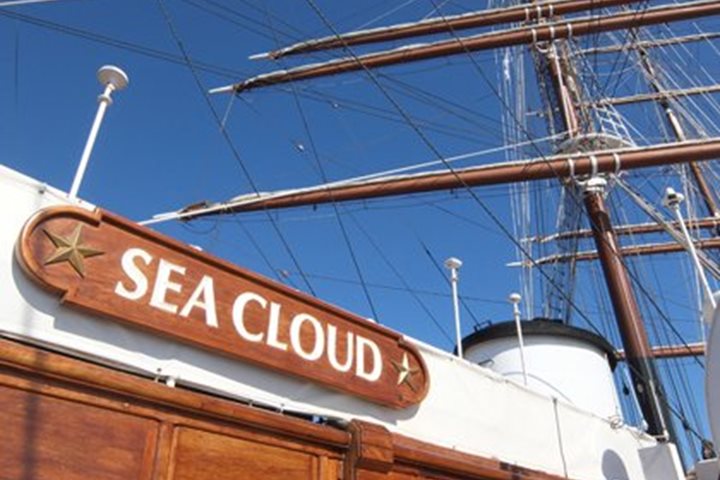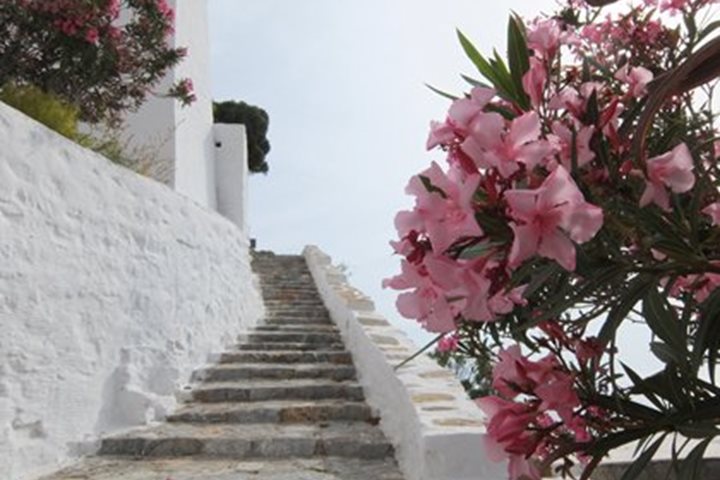The Sea Cloud docked at the port city of Kusadasi at 7:20a.m. The deck was all hustle and bustle as guests were up early and packed for their journey to the ancient city of Ephesus and also for disembarkation. The temperature was cool in the low 70’s and the sky was overcast—a perfect day for visiting Ephesus I thought. Ephesus sits low between two ranges of hills, is made entirely of marble, including the streets and has little shade. Hence my welcoming the cloud cover. And we were not to be disappointed as it was cool the entire day. We boarded our coaches, greeted our Turkish guides and we were off for the 20-minute drive to the ancient city.
We entered this fabled city from the upper side so as to be able to visit while walking steadily downhill. We entered from the Odeon side of the city, that place where musical concerts were held, important matters concerning the city were discussed, etc. Immediately to the left of the Odeon is the Tempe of Isis, testifying to the Roman’s acceptance of many different religions as the cult of Isis was Egyptian and great vogue in the Hellenistic period. Granite columns especially imported to build the Egyptian goddess’s temple were strewn about. As we proceeded down the main street, which would have had many shops facing the street and sidewalks, we passed innumerable beautifully carved inscriptions in both Greek and Latin, reminding us of the pluralism of cultures in Ephesus and the dominance of Roman architecture for the city’s last few centuries.
For some of us the visit to the fabled Roman villas will always remain a vivid memory. Villa number one was approximately 40,000 square feet with multiple bedrooms, running water, private baths and toilet facilities, and forced hot air heat. It was the home of one of the Roman consuls and of course one of the wealthiest men in this part of the empire. The frescoes and mosaics were breathtaking and the colors on some of the walls were still vivid, deep reds, greens, and blue. The mosaic of Dionysus and Artemis were as vivid as a modern portrait and they were on the floor! The hydrology of this amazing city is quite startling. We saw the complex series of terracotta pipes bring fresh potable water from the surrounding mountains to the city and the larger waste pipes transporting waste outside the city with clean out valves every 15 or so feet.
The two last major structures we visited were the dramatically beautiful multi-story library built by Consul Gaius Julius Aquila (ca. 101CE) and the great theatre. This latter structure built into the side of the hill (Mt. Pion) was capable of seating 25,000 spectators. Used principally for theatrical performances, for example the plays of the Greek tragedian Sophocles or the Roman comic playwright Terrence, it—or so tradition has it—hosted gladiatorial combat and animal fighting in the 4th century. If this is true, it is an anomaly as such blood sports were traditionally only held in the Roman amphitheatres, which were built outside the city walls. Furthermore, this theatre was the site for St. Paul’s preaching and of course was the place where he almost lost his life. Saint Luke gives the account of Paul’s stay in Ephesus in “Acts of the Apostles” chapters 19-21. Paul’s preaching against the goddess Artemis and the selling of her image in small silver figurines so angered the silver smiths of Ephesus that the leader of this group, one Demetriousby name, urged his fellow citizens to rid the city of Paul. Paul and his disciples were warned that they would be attacked and they fled the city, never to return. We left this fabled city having touched a historical world that has influenced our modern life in ways we may still not fully understand.









